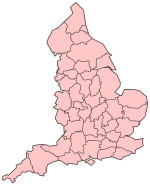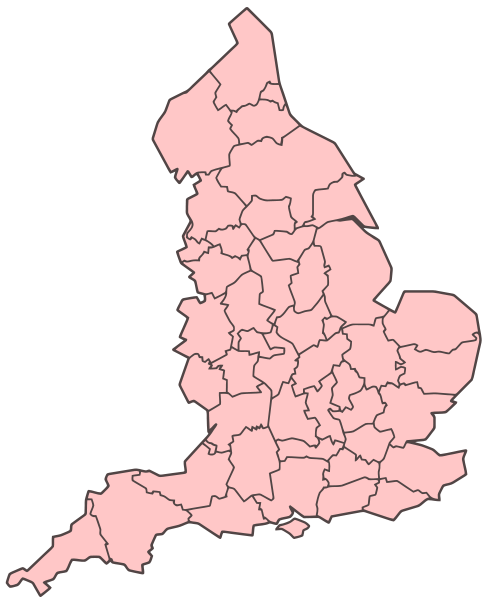- Ceremonial counties of England
-
Ceremonial counties (England) 
Also known as Geographical counties Category Lieutenancy areas Location England Found in Regions Number 48 (as of 2009) Populations 8,000–7,548,600 Areas 3–8,611 km² Densities 62–4,806/km² The ceremonial counties are areas of England to which are appointed a Lord Lieutenant, and are defined by the government as counties and areas for the purposes of the Lieutenancies Act 1997 with reference to the metropolitan and non-metropolitan counties of England and Lieutenancies Act 1997. They are often used in a geographic reference frame, and in this capacity are sometimes called geographical counties.[1]
Contents
Map
Not shown: City of London
History
 Ceremonial counties before the creation of Greater London in 1965 (showing counties corporate as part of the main counties.)
Ceremonial counties before the creation of Greater London in 1965 (showing counties corporate as part of the main counties.)
The concept of the counties used for the Lieutenancy differing from those used for administrative purposes is not a new one: some counties corporate were appointed separate Lieutenants from the larger county (often the posts would be held jointly), and the three Ridings of Yorkshire had been treated as three counties for Lieutenancy since the 17th century.
The Local Government Act 1888 set up county councils to take over the administrative functions of Quarter Sessions in the counties. It created new entities called "administrative counties" that constituted all the county apart from the county boroughs: also some traditional subdivisions of counties were constituted administrative counties, for instance the Soke of Peterborough in Northamptonshire and the Isle of Ely in Cambridgeshire. The Act further established that areas that were part of an administrative county would be part of the county for all purposes. The largest difference was the existence of the County of London, created both an administrative county and a "county" by the Act, which covered parts of the historic counties of Middlesex, Kent and Surrey. Other differences were small and resulted from the constraint that urban sanitary districts (and later urban districts and municipal boroughs) were not permitted to straddle county boundaries.
Apart from in Yorkshire, areas that were subdivided were retained as a single ceremonial county. For example, the administrative counties of East Suffolk and West Suffolk, along with the county borough of Ipswich, were considered to make up a single ceremonial county of Suffolk, and the administrative county of the Isle of Wight was part of the ceremonial county of Hampshire.
The term Ceremonial County for these entities is an anachronism—at the time they were shown on Ordnance Survey maps by the name "counties" or "geographical counties", and were referred to in the Local Government Act 1888 as simply "counties".
Apart from minor boundary revisions (for example, Caversham, a town in Oxfordshire, becoming part of Reading county borough and thus of Berkshire, in 1911), these areas changed little until the 1965 creation of Greater London and Huntingdon and Peterborough, which resulted in the abolition of the offices of Lord Lieutenant of Middlesex, Lord Lieutenant of the County of London and Lord Lieutenant of Huntingdonshire and the creation of the Lord Lieutenant of Greater London and Lord Lieutenant of Huntingdon and Peterborough.
In 1974, administrative counties and county boroughs were abolished, and a major reform took place. At this time, Lieutenancy was redefined to use the new metropolitan and non-metropolitan counties directly.
Following a further rearrangement in 1996, Avon, Cleveland, Hereford and Worcester, and Humberside were abolished. This led to a resurrection of a distinction between the local government counties and the ceremonial or geographical counties used for Lieutenancy, and also to the adoption of the term "ceremonial counties", which although not used in statute was used in the House of Commons prior to the arrangements coming into effect.[2]
Avon was mostly split between Gloucestershire and Somerset, with Bristol regaining its status of a county in itself. Cleveland was partitioned between North Yorkshire and County Durham. Hereford and Worcester was split into Herefordshire and Worcestershire. Humberside was split between Lincolnshire and a new ceremonial county of East Riding of Yorkshire. Also at this time, Rutland was restored as a ceremonial county. Many county boroughs were re-established as "unitary authorities" which involves establishing the area as an administrative county, but usually not as a ceremonial county.
Most ceremonial counties are therefore defined today as groups of local authority areas; the same situation as prevailed between 1889 and 1974. The Association of British Counties, a traditional counties lobbying group, have suggested that the ceremonial counties could be restored to their ancient boundaries, or as near as is practicable.
Definition
The Lieutenancies Act 1997 defines counties for the purposes of lieutenancies in terms of local government areas created by the Local Government Act 1972 as amended. Although the term is not used in the Act, those counties are known as "Ceremonial Counties". Schedule 1, paragraphs 2–5[3] as amended[4] (most recently in 2009[5] defines them as:
- Bedfordshire, consisting of Bedford, Central Bedfordshire and Luton
- Berkshire
- City of Bristol[6]
- Buckinghamshire, including Milton Keynes
- Cambridgeshire, including Peterborough
- Cheshire, consisting of Cheshire East, Cheshire West and Chester, Halton and Warrington
- City of London[7]
- Cornwall, including Isles of Scilly
- Cumbria
- Derbyshire, including Derby
- Devon, including Plymouth and Torbay
- Dorset, including Bournemouth and Poole
- Durham, including Darlington, Hartlepool, and Stockton-on-Tees north of the River Tees
- East Riding of Yorkshire, including Kingston-upon-Hull
- East Sussex, including Brighton and Hove
- Essex, including Southend-on-Sea and Thurrock
- Gloucestershire, including South Gloucestershire
- Greater London, excluding the City of London
- Greater Manchester
- Hampshire, including Southampton and Portsmouth
- Herefordshire
- Hertfordshire
- Isle of Wight
- Kent, including Medway
- Lancashire, including Blackburn with Darwen, and Blackpool
- Leicestershire, including Leicester
- Lincolnshire, including North Lincolnshire, and North East Lincolnshire
- Merseyside
- Norfolk
- North Yorkshire, including York, Middlesbrough, Redcar and Cleveland, and Stockton-on-Tees south of the River Tees
- Northamptonshire
- Northumberland
- Nottinghamshire, including Nottingham
- Oxfordshire
- Rutland
- Shropshire, including Telford and Wrekin
- Somerset, including Bath and North East Somerset and North Somerset
- South Yorkshire
- Staffordshire, including Stoke-on-Trent
- Suffolk
- Surrey
- Tyne and Wear
- Warwickshire
- West Midlands
- West Sussex
- West Yorkshire
- Wiltshire, including Swindon
- Worcestershire
Lieutenancy areas in 1890
- Bedfordshire
- Berkshire
- Buckinghamshire
- Cambridgeshire, including Isle of Ely
- Cheshire
- held jointly with Chester
- Cornwall
- Cumberland
- Derbyshire
- Devon
- held jointly with Exeter
- Dorset
- held jointly with Poole
- Durham
- Essex
- Gloucestershire
- held jointly with Gloucester and Bristol
- Herefordshire
- Hertfordshire
- Huntingdonshire
- Kent
- held jointly with Canterbury
- Lancashire
- Leicestershire
- Lincolnshire
- held jointly with Lincoln
- City of London, having commissioners of Lieutenancy
- County of London
- Middlesex
- Norfolk
- held jointly with Norwich
- Northamptonshire, including the Soke of Peterborough
- Northumberland
- held jointly with Berwick-upon-Tweed and Newcastle upon Tyne
- Nottinghamshire
- held jointly with Nottingham
- Oxfordshire
- Rutland
- Salop (Shropshire)
- Somerset
- Southamptonshire (Hampshire)
- held jointly with Southampton
- Staffordshire
- held jointly with Lichfield
- Suffolk
- Sussex
- Warwickshire
- Westmorland
- Wiltshire
- Worcestershire
- held jointly with Worcester
- Yorkshire—had three Lieutenants, one for each of the three ridings
- East Riding, held jointly with Kingston upon Hull
- North Riding
- West Riding, held jointly with York
See also
- Lieutenancy areas of Scotland
- List of Ancient Woods in England
- List of articles about local government in the United Kingdom
- Preserved counties of Wales
References
- ^ "History of the counties". jonathan.rawle.org. Jonathan Rawle. 2007. http://jonathan.rawle.org/hyperpedia/counties/history.php. Retrieved 2007-12-08.
- ^ House of Commons Hansard Written Answers for 29 Feb 1996 (pt 8)
- ^ Official text of the Lieutenancies Act 1997 - Schedule 1: Counties and areas for the purposes of the lieutenancies in Great Britain as in force today (including any amendments) within the United Kingdom, from the UK Statute Law Database Last acessed:2011-05-03
- ^ Official text of the Lord-Lieutenants - The Local Government Changes for England (Lord-Lieutenants and Sheriffs) Order 1997 as originally enacted or made within the United Kingdom, from the UK Statute Law Database Last acessed:2011-05-3 }}
- ^ Official text of the The Local Government (Structural Changes) (Miscellaneous Amendments and Other Provision) Order 2009 (SI 2009/837) as originally enacted or made within the United Kingdom, from the UK Statute Law Database Last acessed:2011-05-03
- ^ Official text of the The Avon (Structural Change) Order 1995 (S.I. 1995/493) Part III: New Counties as originally enacted or made within the United Kingdom, from the UK Statute Law Database Last acessed:2011-05-03
- ^ Because the City of London has a Commission of Lieutenancy rather than a single Lord Lieutenant, it is treated as a county for some but not all purposes of the Lieutenancy Act (Schedule 1 paragraph 4)
External links
- Official text of the Lieutenancies Act 1997 as amended and in force today within the United Kingdom, from the UK Statute Law Database
- Official text of the Lieutenancies Act 1997 as originally enacted within the United Kingdom, from the UK Statute Law Database
 Administrative geography of the United Kingdom
Administrative geography of the United KingdomUnited Kingdom • Local government • History England • Local government • History Subdivisions: Regions • Ceremonial counties • Metropolitan and non-metropolitan counties • Unitary authorities • Districts (list) • Civil parishes (list)Northern Ireland • Local government • History Subdivisions: Counties • DistrictsScotland • Local government • History Wales • Local government • History  Subdivisions of England
Subdivisions of EnglandRegion County Metropolitan • Non-metropolitan • CeremonialDistrict Metropolitan • Non-metropolitan • London borough • City of London • Unitary authority • Isles of ScillyCivil parish Categories:- England-related lists
- Ceremonial counties
- Counties of England
Wikimedia Foundation. 2010.


